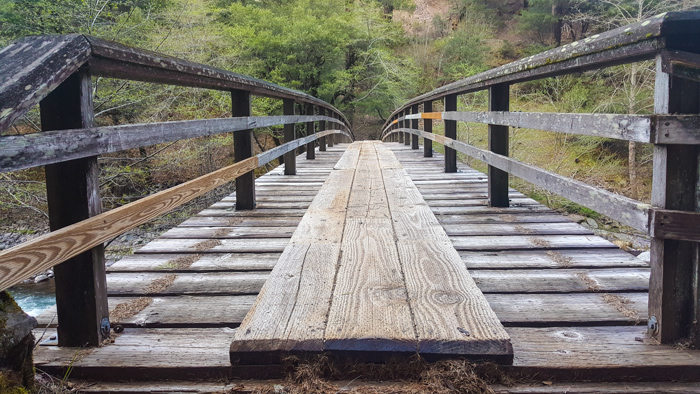Bridges

Bridges! What handy, helpful, beautiful inventions! Connecting two sides across impossible (or merely inconvenient) gaps, bridges allow us to get from here to there and consider separate things as one. Trail bridges especially fascinate me, helping me enjoy travelling through the wilderness and giving me insights into life.
Every bridge is a solution to a problem. Raging water, swampy muck, or deep ravine are all impediments to forward progress on the trail. Rather than have thousands of people take off their shoes or rope up or turn around, a crew invests time, money, and effort to span the problem once and for all.
Because each problem is unique and solutions are constrained by differing rules and resources, every bridge represents a creative answer to the difficulty. In the wilderness, no power tools can be used. Motorized vehicles cannot transport the materials to the site. This may necessitate laborious hauls on horses or using materials at hand to construct the barest of bridges. Other places may be in national parks where limitations are minimal and form may be just as important as function.

Just outside the wilderness boundary, this bridge was built over Agnes Creek with steel and flair.
The architect in me likes to pause at every bridge and consider some of those factors. Tressles, trusses, arches, and even whittled logs do not just appear out of nowhere. Someone had to take into account the needs, the resources, and the surroundings to design a lasting structure. Put an arch over a swamp and it will soon spread and collapse into the mire. Put a couple of unsupported logs with boards over a wide ravine and soon hikers and backpacks will be floating downriver.

Notice the rock walls and footings on either side of this bridge over Squaw Creek in northern California.
Every bridge is a labor of love completed for the well-being of those to come. The future hikers may be appreciative or they may be almost unaware of the crossing. Nonetheless, time, effort, and money was expended for unknown people to walk comfortably and continuously through the woods.
The journey of life also requires bridges—between individuals, between groups, between people and adverse circumstances. Therefore, time, effort, and money need to be expended to bridge the social and spiritual gaps. We can ignore those who are different from us and we can hate those opposing us, or we can reach out with our hearts and our hands to form a bridge across the gulf.
“Every association of life calls for the exercise of self-control, forbearance, and sympathy. We differ so widely in disposition, habits, education, that our ways of looking at things vary. We judge differently. Our understanding of truth, our ideas in regard to the conduct of life, are not in all respects the same. There are no two whose experience is alike in every particular. The trials of one are not the trials of another. The duties that one finds light are to another most difficult and perplexing.” (MH 483)

Be it ever so fragile, every bridge is ever so helpful! (North Cascades National Park, Washington)
Quite often, communication is all that is needed to link two sides together. Taking the time and opening heart-space within ourselves to truly hear both sides of the story might shrink the gap so small that a bridge is no longer needed because the two have become one.
Building bridges always requires effort on both sides. The ground is surveyed and the footings are prepared before the first beam or cable is strung. It seems like this is an observation worth remembering before we enter the sanctuary to worship with our brothers and sisters, or before we begin that committee meeting or church project. Both sides, all sides, must reach out towards each other. We endure the pain of isolation and separation, or we endure the pain of bridge-building, but there is always pain in this world. Just ask the Crucified One.

Not fancy, but this simple wilderness bridge exudes strength and safety. (Northern Washington)
“It is acquaintance that awakens sympathy, and sympathy is the spring of effective ministry.” (Ed. 269) And ministry in the church or out of the church is all about building bridges, because on the trails of life or the great journey of life, they are oh so helpful and ever so wonderful.
So when you can cross a bridge to connect with the other side. Take it. When you have the sacrificial opportunity to be a bridge between opposing sides. Be it. When you can walk hand in hand with a brother or sister over a bridge. Do it.

Do not be afraid to help. Even a broken log helps hikers cross the raging Kennedy Creek. (Near Glacier Peak, Washington)
by Ed Lyons, 6/22/2018
